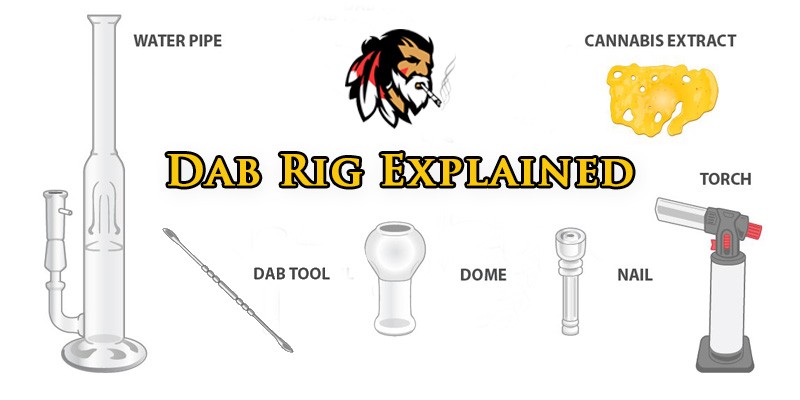Vape
Dab Rig Explained
There’s a lot of confusing jargon out there in the cannabis community. One of the most regularly perplexing terms is “dab rig.” If you have been stumped by this one, rejoice! By the time you’re finished reading this article, you’ll know what a dab rig is, how it works, and what to look for to buy your own!
Dab rigs have become increasingly popular as many cannabis consumers turn away from traditional standard flower and toward healthier, more exciting, more efficient, and more complex ways of lighting up. They are a sign of where cannabis culture is heading, and therefore any self-respecting stoner should know what they are. So—without further ado—what is a dab rig, anyway?
IT’S THE SAME THING AS A BONG, RIGHT?
Wrong.
Granted, dab rigs and bongs are similar: they’re often made of glass, employ water to cool hits, and are used for inhaling cannabinoids. Aside from this, there are very noteworthy differences which distinguish them. The main distinction—and that from which all others follow—is what the thing is used for. Put simply, bongs are used for smoking dried cannabis flower, whereas dab rigs are used to vaporize cannabis concentrates.
Rosin, wax, shatter, oil—these are the products for which dab rigs are useful. The first big distinction is what I’ll hereby dub “the locus of action.” I use this fancy terminology to describe the point where cannabis meets heat. The hot seat, if you will. Bongs will use a traditional bowl—a concave piece of metal, glass, or other material that holds the ground cannabis flower. With the flower held securely, simply introduce heat and inhale. Dab rigs, on the other hand, have a nail or banger. These are most often made from glass, titanium, or quartz, and tend to be smaller than traditional bowls. The main difference between the two is that with a dab rig, the cannabis product is introduced to a hot nail (as opposed to heat being added to cannabis-filled bong bowl). These nails are intended to be heated by a butane torch, and when optimal temperature is reached, cannabis concentrate is added to the hot surface of the nail and vaporized.
The other main difference between bongs and dab rigs is the fact that the latter tend to be more compact. The properties of smoke allow for substantial freedom in bong design. As long as it stays contained, smoke can travel a great distance through a number of percolators and not lose any of its potency. Indeed, cannabis smoke sealed in a bong chamber could be inhaled minutes later and still pack a potent punch—in fact, the hit would almost be better in that it would not be hot at all (though a little stale).
This would not work with vapour. Because of the nature of vapour, it must be inhaled as quickly as possible in order to attain the best quality hit. If the vapour needs to travel too far through a maze of glass and water, the goods will condense! To this end, dabs only employ a minimal amount of water.
SO HOW DOES DAB RIG WORK?
We get it, a dab rig isn’t a bong, but how does it work? Well, aside from the distinctions, quite a bit like a bong. Here’s a breakdown in the steps:
Heat: Because of the way a dab rig is engineered, heating the nail is actually the first step (before even adding the concentrate). A butane torch is often used to heat the nail until it is absolutely red hot. If the nail material actually allows for a red glow, the prudent dab enthusiast applies the flame until they see this tell-tale sign of considerable heat.
Wait: Once the nail is heated until red hot, the dab enthusiast waits for it to cool to optimal temperature. The amount of wait time depends on the material of the nail and preferences of the dab enthusiast, but the typical range is 20-40 seconds.
Apply: The desired cannabis concentrate is then applied to the nail using a dabber or “wand.” Being a concentrate, only a small amount is required. The dab enthusiast is well-advised to cover as much of the interior surface of the nail as possible to achieve maximum and uniform vaporization.
Draw: Forming a seal between their mouth and the mouthpiece, the dab enthusiast begins to draw the moment the concentrate touches the nail and vapour is produced. This vapour is then drawn into the rig.
Cool: Like a bong, dab rigs use percolators or (less frequently) recyclers to cool the vapour. Again, these are minimal compared to bongs, and it is paramount that the vapour passes through as quickly as possible so as to not lose too much potency.
Inhale: Finally, the cooled vapour reaches the mouth of the dab enthusiast, and she gets stoned as f*@%.
WHERE TO BEGIN
Now that you have an idea of what dab rigs are and how they work, you may be interested in getting one of your own. But where to begin?
First things first, ask yourself if you truly enjoy and have experience with concentrates. Dab rigs are relatively expensive, and aren’t completely necessary if you aren’t devoted to the world of concentrates. You could enjoy concentrates just as well with a vape pen, particularly if you don’t have much experience with them. Dab rigs provide smoother hits and a more robust experience for those concentrate consumers who have decided that they’re worth the money.
On the note of price, consider that the accessories surrounding dab rigs can quickly become rather expensive. Therefore, it is important to build your rig around your budget, and not the other way around. Many dab rigs are highly customizable and can be quite elaborate, so bear in mind that you can generally switch out parts and upgrade as your tastes become more demanding.
In general, it’s best to start small and build your way up. Different components of dab rigs will each have their own advantages and drawbacks, so be patient and do your research in order to end up with the absolute best setup for your needs.


